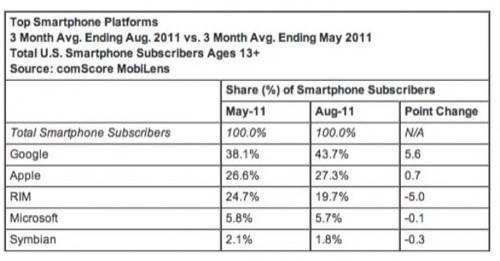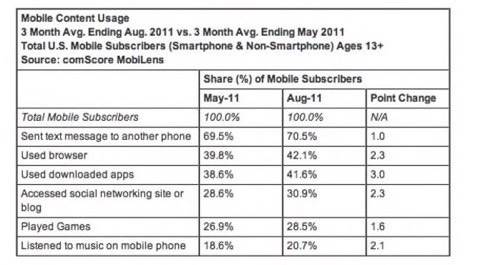The latest U.S. mobile market share numbers from comScore are out and Android is still rolling. On the flip side, the decline of Research In Motion’s BlackBerry platform is starting to accelerate. Apple held steady and made a slight gain through the summer even though the only tangible evidence of a new iPhone was speculation emanating from the technosphere.

As of August, Android now controls 43.7% of the U.S. smartphone market share. Of the 84.5 million U.S. consumers with smartphones, that means Android is in the hands of about 36.9 million of them. Android is up 5.6% since May. Apple is up 0.7% from 26.6% to 27.3% in the same time frame. The growth of Android and Apple came at the expense of RIM, which lost 5% from 24.7% to 19.7% in the United States. The blanket numbers are interesting at face value, but there are undercurrents guiding the market that may not be readily apparent.
Angry Android Eats BlackBerries
Waterloo, Canada-based RIM has a giant problem. It is called Android. It also faces another giant obstacle to retaining market share – itself. The BlackBerry OS is outdated and unglamorous. BlackBerry is hemorrhaging in the consumer market and its enterprise base is starting to get whittled away by the iPhone and more sophisticated mobile device management programs in IT departments. The enterprise base will only erode more as Android security matures through companies like 3LM and BoxTone.


RIM’s hopes rest with its new mobile operating system based of QNX (what the PlayBook was built on) that should be ported to smartphones early next year. The company is also hoping to ride Android’s coattail by integrating a virtual application layer that will run Android apps on BlackBerry devices. That is in the works and is rumored to be ready later this year.
If Consumers Love the iPhone, Why Does Android Grow?
To a certain extent, consumers prefer the iPhone over almost everything. So, why does Android continue to grow like ivy up a brick chimney? It all boils down to ubiquity. The iPhone just came out for Verizon in March and it has never had a concurrent series of new phones released at the same time. That was one of the reasons that you heard so many “there will be an iPhone 4S and an iPhone 5” rumors heading up to yesterday’s announcement from Apple. Basically, if Apple could spread the a multi-series iPhone to every available carrier along different price levels, it would clean up.

That is how Android has grown. When Samsung released the Galaxy S to all four major U.S. carriers at the same time, it was a stroke of genius. Android everywhere. Good phones, middle of the road. Up and down the price spectrum. No need to change your carrier or break your contract for a good device because Android had you covered.
Apple’s ploy is not the same. Basically, it decides that its multi-series line will just be the older versions of the device, put on sale. That will certainly help liquidate a lot of Apple inventory and give a boost to the lower end of the Apple spectrum. Yet, the competition among the Android ecosystem means that there is a brand new shiny device with Google’s mobile operating system running almost every other week. Say what you want about the quality of Android as an OS, but the scheme works – if you cannot outmaneuver your competition, smother it with sheer numbers.
Samsung was the largest original equipment manufacturer in August with 25.3% (both smart and feature phones). Motorola and LG held the second and third spots with Apple coming in fourth with 9.8% of the of the OEM pie. RIM lost a percentage point to place fifth at 7.1%.
The most common activities for mobile users (smart and feature phones) was texting, then browser use and downloading applications. See the chart below and note that every category saw growth through the summer.

Consumers – What phone do you use and why did you buy it? Tell us the street level version of why these numbers make sense in the comments.









